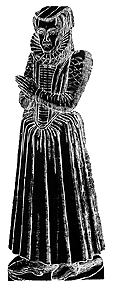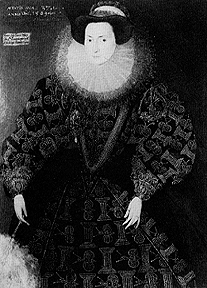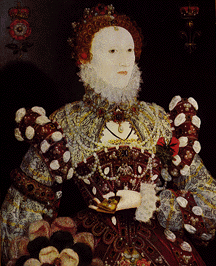
Queen Elizabeth's
Influence on Elizabethan Fashion
by Drea Leed
No site or book on Elizabethan costume can be complete without a mention
of the woman who gave the era (and the era's costume) its name: Queen
Elizabeth.
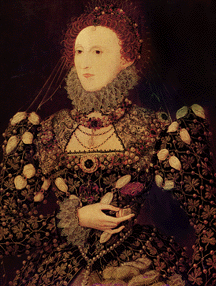 Both Bess and her father were renowned for their ostentation in dress.
Who hasn't seen the portrait of King Henry where he stands, wide enough to
bridge a small stream, ostentatiously draped in a king's ransom of silks,
satins and jewels? if possible, Elizabeth outshone even her own father in
the magnificence of her apparal--In some of her portraits, you can barely
see the gown for all of the jewels, embroidery and decoration applied.
Both Bess and her father were renowned for their ostentation in dress.
Who hasn't seen the portrait of King Henry where he stands, wide enough to
bridge a small stream, ostentatiously draped in a king's ransom of silks,
satins and jewels? if possible, Elizabeth outshone even her own father in
the magnificence of her apparal--In some of her portraits, you can barely
see the gown for all of the jewels, embroidery and decoration applied.
From Rags to Riches
There's a popular belief that Elizabeth's astounding wardrobe had its
roots in her childhood--that she had an insatiable appetite for new
and beautiful gowns, each richer than the next, because as a child she
was
denied all but the most basic accoutrements and clothing. At one point
her nurse wrote a letter to the king, pleading that the small
girl be give enough clothes that she need not run about in rags and
|
beseeching you to be [a] good lord to my lady...that she
may have some raiment for she hath neither gown, not kirtle nor sleeves,
nor railes, nor body stitchets, nor handkerchiefs, nor mufflers nor
biggins. All this her grace must have. I have driven off as long as I
can, that be my troth I can drive it no longer. Beseeching you my lord
that ye will see that her grace may have that [which] is needful for her.
|
Though there can be no doubt that the circumstances of Elizabeth's youth
and her mother's death had a great influence upon her future political
and personal decisions, the
Queen's ostentation in dress was not due simply to vanity and a craving
for rich dresses to make up for the impoverished wardrobe of her youth.
Her wardrobe was used for political ends as well.
Bess-Dressed to Impress
One of Elizabeth's remarkable traits was her ability to use any situation
to her political advantage. Rich gowns impress people; this is an obvious
fact. So Elizabeth's wardrobe was designed, first and formost, to
impress--and to be suitable to her station as ruling monarch. The rich
fabrics and jewels conveyed incredible wealth, power and
prestige. Elizabeth's grandfather Henry the VIIth had been subject to
mutterings about penury and miserliness as a result of his austere
wardrobe; his granddaughter's gowns suggessed generosity and the
willingness (and resources) to spend vast sums on personal adornment.
People referred to Queen Bess as a goddess, as queen of heaven, and she
certainly dressed the part.
Behind this facade of staggeringly expensive splendor, however, was the
reality of limited funds, carefully budgeted expenditures, and a canny use
of resources and materials. Elizabeth's wardrobe accounts were detailed
and exacting, listing exactly how much material was bought, who from, how
much it cost, and what it was used for. In fact, these accounts are one
of the main sources of information about costume of the time.

Although her wardrobe far outshone any other in the land, Elizabeth's
clothing expenses were actually quite modest, compared to those of other
royals--only a fifth of that spent by her successor King James, for
example.
Once a gown or item of clothing was made, it was often altered to
accomodate changing fashions and tastes. Sleeves were replaced with other
sleeves, panels were added and removed from skirts, worn garments were
picked apart and their fabric used for other wardrobe items, and trim
and embroidery recycled from one gown to the next.
In addition, the queen often paid ladies in waiting, valets, and others
in her service
with gowns, foreparts, and other pieces of clothing from the Royal
Wardrobe.
Fortunately, Elizabeth didn't have to bear the staggering expense of her
wardrobe completely on her own.
As her reign continued, more and more people began bringing the Queen
clothing as a New Year's present in an attempt to gain favor with her.
There were dozens of stomachers, foreparts and sleeves given every year,
often lavishly embroidered and breathtakingly decorated. In fact,
Elizabeth's first pair of knitted silk stockings came to her as a gift on
New Year's Day. She was so delighted with them that she immediately
commissioned more to be made for her, and soon many courtiers of her court
were
beggaring themselves to afford the terribly fashionable, and terribly
expensive, silk hose that the Queen was so fond of.
Queen of International Fashion
Wealth and power weren't the only statements that Elizabeth made through
her wardrobe. She was exceedingly interested in the fashions of other
lands as well. Royalty has long been considered a driving force in the
exchange of fashions between countries (Katherine of Aragon's importation
of the Spanish Farthingale into England, for example.) Though many other
factors exist in the ebb and
flow of changing national styles, Elizabeth's fondness for foreign dress
had a significant impact on English fashion of the time as well as her own
wardrobe. As one visiting emmisary related:
"The Quene said she had Clothes of every sort, which every day thereafter,
so long as I was there, she changed. One day she had the English Weed,
another the French, and another the Italian and so forth. She asked me
which of them became her best? I answered, in my judgement the Italian
dress, which answer I found pleased her well, for she delighted to shew
her golden coloured hair..."
Her wardrobe accounts mention dresses from all over europe:
"A Gowne of crymsen satten of the italian fation","A Venecian gown of
crimsen velvet","a Gowne of blak vellat of the polony (polish) fation",
"One French gowne of Russet satten", "One Dutch cloake", "a Flanders
gowne of Black velvet cutt all over"...the list goes on and on.
She had patterns and sample bodices sent abroad so that the French,
Italians, and even Germans might make gowns to her size. She even
imported tailors from abroad. Italian, French and most especially Spanish
styles filtered into England at an increasing rate during Elizabeth's
reign, to be absorbed into English style.
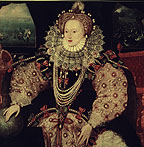 Elizabeth even managed to use foreign fashions
for her own political ends. When her marriage
negotiations were at their height with the Anjous, she commissioned a
portrait of herself to be sent to Catherine de' Medici. (see picture to
the right) In the portrait,
Elizabeth is dressed in the height of French court fashion at the time.
Apparantly, it met with a favourable response:
Elizabeth even managed to use foreign fashions
for her own political ends. When her marriage
negotiations were at their height with the Anjous, she commissioned a
portrait of herself to be sent to Catherine de' Medici. (see picture to
the right) In the portrait,
Elizabeth is dressed in the height of French court fashion at the time.
Apparantly, it met with a favourable response:
"The ladies did highly commend the queen my sovereign's rare gifts and
princely comliness with exceeding praises and admiration...the great
princesses did note and were very much satisfied to see her majesty
appareled and attired all over a la francoise".
Naturally, what the Queen wore greatly influenced those close to her. Her
ladies in waiting wore her old dresses; other women strove to imitate the
style of the Queen and her ladies. New fashions filtered gradually down
from court to society in general, rather like ripples in a pond, where
they often assumed a simpler and more practical aspect than the gowns worn
by the Queen and her companions. It was rather similar to the process by
which a gown modeled on a Parisian runway eventually shows up a few
months later, more practically designed and less outrageously priced, at
the local department store.
This process could take some time; Lacking modern methods of communication
such as fashion magazines and photographs, fashions in rural areas of
England were often years or even decades behind London's. And the poorer
the person, the less likely they were to keep their wardrobe up to date.
For example, below are a funeral brass and a portrait created in the same
year, 1589. The left was a representation of a lady of lesser nobility,
the right one of cutting-edge fashion.
Elizabeth's influence on fashion extended beyond women's clothing. The
opulence of her wardrobe began to have an effect on male garments as well.
Courtiers vied with eachother to be seen in the most flashy, dashing,
expensive and fashionable outfits.
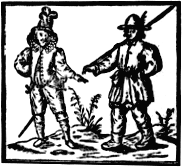
When Elizabeth began her reign, male fashions remained, for the most part,
similar to those worn when her father and brother were king. The male
sillhouette was broad shouldered and formidable, using masses of rich
fabrics, bands of contrasting color and elaborate embroidery motifs to
display the wealth and magnificence of the wearer.
However, both male and female fashion became far busier and more elaborate
As Elizabeth's reign continued.
Ruffs became higher and larger, and skirts and sleeves became wider and
wider. Bodices became more busily decorated, covered completely in braid,
trim, jewels, metal and silk embroidery, or other forms of decoration.
Male fashions also followed this trend and became stiffer, more busily
decorated with puffs, pinking
and slashes, and generally more contrived in appearance. The Peascod
belly evolved during
Elizabeth's reign. Men would sometimes wear girdles, the equivalent of
the female corset, to obtain the wasp-waisted look in fashion at court.
Indeed, the difference between the fashionable courtier and a countryman
was as great as that between women's dress of London and that of the
rural areas.
By the time of Elizabeth's death, the look of English fashion had changed
entirely from the graceful, simple Tudor styles which had existed at the
beginning of her reign. Below are two pictures: one of fashionable dress during Elizabeth's youth,
the other of a court gown worn at the end of the Queen's reign. The
contrast speaks for itself.

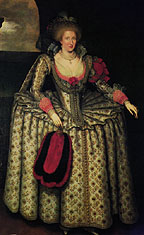
The evolution of a nation's fashion is a process influenced by so many
factors that pinpointing an style's origin or originator is almost always
impossible. Elizabeth, however, had a more powerful influence over her
country's changing styles than almost any other monarch before or since.
As a powerful woman and an anointed monarch, she--or rather, the
combination of her royalty and
her famed "virginity"-- became an icon of sorts. Poems were written to
her, where she was likened to anything from a queen of Faerie
to a goddess in her own right.
 Far more portraits were
painted or her than of her father or her successor, King James, of
which copies of were made and distributed freely to the populace. The
increasing popularity of printing and engraving opened another avenue
whereby her image could displayed to a wide audience.
Far more portraits were
painted or her than of her father or her successor, King James, of
which copies of were made and distributed freely to the populace. The
increasing popularity of printing and engraving opened another avenue
whereby her image could displayed to a wide audience.
In this way, fashions at court--which were spearheaded by the Queen's
fashions, both through hand-me-downs to her ladies in waiting and through
imitation by those wishing to gain notice and approval in the Queen's
eyes--greatly influenced English Costume.
Related Links:
Elizabeth I Portrait Gallery
A Tour of 16th Century Fashion
Home
 Both Bess and her father were renowned for their ostentation in dress.
Who hasn't seen the portrait of King Henry where he stands, wide enough to
bridge a small stream, ostentatiously draped in a king's ransom of silks,
satins and jewels? if possible, Elizabeth outshone even her own father in
the magnificence of her apparal--In some of her portraits, you can barely
see the gown for all of the jewels, embroidery and decoration applied.
Both Bess and her father were renowned for their ostentation in dress.
Who hasn't seen the portrait of King Henry where he stands, wide enough to
bridge a small stream, ostentatiously draped in a king's ransom of silks,
satins and jewels? if possible, Elizabeth outshone even her own father in
the magnificence of her apparal--In some of her portraits, you can barely
see the gown for all of the jewels, embroidery and decoration applied.


 Elizabeth even managed to use foreign fashions
for her own political ends. When her marriage
negotiations were at their height with the Anjous, she commissioned a
portrait of herself to be sent to Catherine de' Medici. (see picture to
the right) In the portrait,
Elizabeth is dressed in the height of French court fashion at the time.
Apparantly, it met with a favourable response:
Elizabeth even managed to use foreign fashions
for her own political ends. When her marriage
negotiations were at their height with the Anjous, she commissioned a
portrait of herself to be sent to Catherine de' Medici. (see picture to
the right) In the portrait,
Elizabeth is dressed in the height of French court fashion at the time.
Apparantly, it met with a favourable response:
